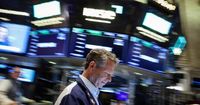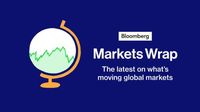Asian stocks experienced a downturn on April 16, 2025, as the repercussions of new U.S. restrictions on chip exports to China began to unfold, particularly impacting Nvidia Corp., a key player in the semiconductor industry. The news sent shockwaves through global markets, leading to a notable drop in U.S. equity-index futures, which fell more than 1.3% for the Nasdaq 100 and 0.8% for the S&P 500. This decline followed Nvidia's significant slump in after-hours trading, highlighting the fragility of investor sentiment amid ongoing trade tensions.
As the global trading landscape shifts, investors are turning to safe-haven assets, driving gold to record demand levels. The precious metal's rise underscores a growing anxiety among traders as they navigate the uncertain waters of international trade relations. In addition to gold, the Swiss franc and euro gained strength against most currencies, reflecting a flight to safety.
On the same day, U.S. Treasuries rallied for a second consecutive day after discussions about potential rule changes that could lower trading costs for banks. This development has sparked interest among investors, who are keen to understand how such changes might influence the broader economic landscape.
On April 15, 2025, markets had shown signs of recovery, albeit modestly. Wall Street closed slightly down, with the Nasdaq dipping only 0.05%, the S&P 500 shedding 0.2%, and the Dow slipping 0.4%. Financial stocks led the charge, buoyed by strong earnings reports from major banks like Bank of America and Citigroup. However, seven out of ten sectors on the S&P 500 ended the day in the red, with consumer cyclicals taking a hit.
Despite the mixed performance, European stocks posted solid gains, with major benchmarks in Germany, the UK, and across Europe rising approximately 1.5%. Asian markets also saw positive momentum, with the MSCI Asia ex-Japan index climbing 1% and Japan's Nikkei 225 gaining 0.8% on April 15.
The dollar showed signs of recovery, rebounding from three-year lows. On April 15, it jumped 1% against the Swiss franc and the dollar index rose 0.5%, snapping a five-day losing streak. However, the backdrop of trade tensions and economic uncertainty has left many analysts questioning the sustainability of this rebound.
In Argentina, stocks reversed course, sliding more than 3% on April 15 after the government lifted capital controls, which had previously allowed the peso to stabilize. The peso had experienced a tumultuous trading session, slumping 10% just a day earlier, before finding some steadiness.
As the markets brace for upcoming economic indicators, including China's first-quarter GDP data and the European Central Bank's interest rate decision, the atmosphere remains one of cautious optimism. Investors are also awaiting comments from U.S. Federal Reserve Chair Jerome Powell regarding the economic outlook, which could further influence market movements.
The global economic environment is rife with uncertainty, particularly as U.S. Treasury Secretary Scott Bessent reiterated the longstanding mantra of a "strong dollar policy". This phrase, once a cornerstone of U.S. economic strategy, now rings hollow to many analysts who see the dollar's dominance waning in the face of shifting global dynamics.
Historically, the strong dollar policy has been about more than just maintaining a favorable exchange rate; it has represented the trust in U.S. financial institutions and the dollar's role as the world's reserve currency. However, the current administration's approach, characterized by tariffs and a focus on domestic interests, has led to skepticism among foreign investors regarding the dollar's future.
Market analysts are closely watching how these dynamics will unfold, particularly in light of the Trump administration's 'America First' agenda, which has raised questions about the reliability of the U.S. as a partner in global trade. As the world navigates these turbulent waters, the potential for further trade conflicts remains a pressing concern.
In summary, the interplay between U.S. trade policies, global market reactions, and investor sentiment continues to shape the economic landscape. With key economic data on the horizon and ongoing trade tensions, the markets are poised for a period of volatility, underscoring the need for investors to remain vigilant and adaptable.





